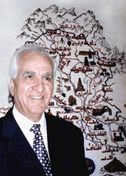Past, Present and Future
Islamic Tourism magazine’s participation at the International Symposium in Damascus proved successful
as copies of the first issue were distributed there and were later on appreciated by those who attended this auspicious event.
Below are our own brief views and comments on the three-day symposium:
If we could travel back to the start of the 20th Century and see how Muslims were living in villages and cities then, we would probably find that most people never really ventured out – and the few who did would have done so for the purposes of pilgrimage (notably Hajj
and Umrah). But visiting religious cities was also an excuse for Muslims not only to experience other Islamic cultures but a pleasant way to spend valuable leisure time.
Today, tourism takes on diverse forms and provides interconnection between different countries, particularly those countries that can afford it. The sight of millions of tourists from America, Europe and Asia, for instance, is common throughout the world, and tourism is itself nowadays a source of income, as well as an excuse for rest and relaxation and learning about other cultures through visiting historical and natural places of interest.
"Europe is today on the verge of a comprehensive union based upon economic
agreements between its constituent states, the first of which was the coal and steel agreement signed in April, 1951, in Paris, and out of which the European Group for Coal and Steel was established to include Belgium, Germany (then, of course, West Germany), France, Italy, Luxemburg and The Netherlands.
Europe is today on the verge of a comprehensive union based upon economic agreements between its constituent states, the first of which was the coal and steel agreement signed in April, 1951, in Paris, and out of which the European Group for Coal and Steel was established to include Belgium, Germany (then, of course, West Germany), France, Italy, Luxemburg and The Netherlands. Coming into force in 1952, one may ask, fifty years on, can those and successive agreements be said to be precursors to what the union of European states is based upon? Or can we perhaps instead argue that tourism and travel among the nations of Europe has been instrumental in promoting such a union, a fact underlined by the adoption in many European countries of a single currency, the Euro? Of course, it goes without saying that industry and commerce are the basic elements for the existence of the European Union, and economic agreements have assured free transportation of goods as well as free movement and flexibility in choices of where to work among Europe’s citizens.
The free movement of citizens has effectively forced member countries to adopt a single currency. This, in many countries that have agreed to adopt the Euro, has entailed giving up what is arguably the main historical
„The impressions tourists bring back to their own countries after returning from a holiday abroad can positively affect the subsequent numbers of potential tourists from a particular country in the future. Countries that can be said to “export” tourists (as opposed to exporting tourism) can have little influence on how many people travel abroad except where the concerns are specifically related to questions of security and politics.
and national symbol of sovereignty in any context, for a new symbol that represents a new Europe. Fluctuations in tourist numbers are the result of many different factors. For instance, those countries that mainly export tourism are influenced by economic factors such as fluctuations in currency, as well as weather conditions. On the other hand, the countries
that are visited by tourists are also affected by the factors mentioned above in addition to competition from "new" tourist countries.
The impressions tourists bring back to their own countries after returning from a holiday abroad can positively affect the subsequent numbers of potential tourists from a particular country in the future. Countries that can be said to “export” tourists (as opposed to exporting tourism) can have little influence on how many people travel abroad except where the concerns are specifically related to questions of security and politics.
Countries that host tourists should actively promote tourism, especially where they obviously share with the arriving tourists the same or similar language and religion. In such instances, the economic benefits of tourist
exchanges would be increased. Whereas tourism is generally subject to fluctuation, to increases and decreases, highs and lows, religious tourism remains a reliable prospect – subject only to political decisions and changing exigencies that could, but often do not in fact, impede or limit the movement of tourists from one country to another. This means that should the countries of the Islamic world pay greater heed to this sector, they
would secure tourist influxes not only on religious occasions but throughout the year.
The main elements of attracting tourists,then, are:
1 - upkeep of historical mosques, sanctuaries and other landmarks, and highlighting them as landmarks of the legacy of Islamic civilization
2 - improving sites of archaeological, historical and tourist interest
3 - paving the roads and pathways that lead to such sites, paying regard to their upkeep and cleaning them regularly
4 - maintenance of different kinds of tourism activities
5 - collaborating with local inhabitants, domestic and official establishments by providing proper accommodation, food, and transport for visitors
6 - showing trust in dealing with human resources that are often the first port of call for tourists when they arrive
7 - welcoming tourists and visitors and introducing the necessary facilities to them
Putting the above criteria into practise would enhance the future of the tourism industry and help tourism per se to flourish. There is perhaps little doubt that tourism and travel remain the foundation for cooperation and exchange among neighbouring countries, especially those that have the same or related languages and religions.
Finally, to those who recognize the potential for tourism and the promotion of Islamic heritage, Islamic Tourism magazine will be seen as a veritable treasure-house of information, annotated with beautiful photographs that are a living testimony to the diverse histories, civilizations and cultures of the Islamic nations. We give you, dear reader, the keys to its gates: open and enjoy....
|

